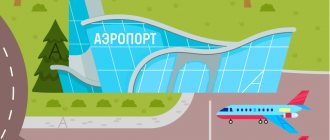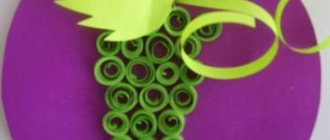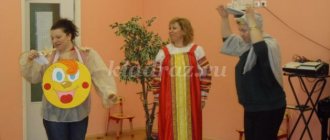Work program "ABVGDeyka" for future first-graders
The content of preparation for training is based on such principles as: taking into account the age and individual characteristics of the child; systematic and consistent; variation and variability; accessibility and sufficiency; visibility; reliability; complexity; relationship with the outside world; use of works of art, integration of all types of art, works of children's creativity; a variety of gaming and creative tasks; variety of types of artistic and creative activities (games, music, artistic speech, theatrical).
Leading activity: game; productive, creative activity. Types of actions in the process of the activities used: analysis of the object; compare and contrast; highlighting the common and the different; implementation of classification; establishing an analogy.
Based on the requirements for the child set out in the basic documents of preschool and primary general education (federal state requirements for the structure of the basic general education program of preschool education and the federal state educational standard for primary general education), a portrait of a preschooler entering first grade has been prepared.
A child entering first grade has the following qualities:
physically developed, masters basic cultural and hygienic skills: dresses and undresses independently; takes care of clothes and shoes; follows the basic rules of a healthy lifestyle; cares for plants, animals, toys, books; knows primary information about himself, family, society, state, world and nature; knows the means of communication and ways of interacting with adults and peers; uses verbal and non-verbal methods of communication; speaks dialogically and constructively interacts with children and adults; consciously and voluntarily constructs a speech utterance in oral form.
The program prepares children for school, providing continuity between preschool and primary general education.
Goals and objectives of the program
Purpose of the program
– successful adaptation of preschool children to new educational conditions and creation of conditions for a humane (comfortable) transition from one educational level to another.
Preparing children for school occupies a special place in the education system. This is due to the child’s difficult adaptation to school. The school places quite high demands on first-graders. A preschool child should be ready not only for new forms of communication. He must have a developed motivational sphere, where curiosity acts as the basis of cognitive activity, and the emotional-volitional and cognitive spheres of mental functions have been formed. A future first-grader must have basic skills in universal educational activities, communication and speech competencies.
MAGAZINE Preschooler.RF
Literacy program "ABVGDEyka" (5-7 years)(educational field: speech development)
Developed by: teacher - speech therapist of MDOU No. 6 Dorzhieva A.A. village Mountain 2012
Ι. Explanatory note
Federal State Standard of Preschool Education
determines target guidelines - social and psychological characteristics of the child’s personality at the stage of completion of preschool education, among which speech occupies one of the central places as an independently formed function, namely: by the end of preschool education, the child understands oral speech well and can express his thoughts and desires.
Preschool age is the most favorable age for the development and education of a child. This is due to the accelerated development of the psychophysiological functions necessary for this period. The child is distinguished by sharpness and freshness of perception, curiosity and vividness of imagination. An important place is occupied by the development of thinking and the process of development of speech perception. Of course, it is important to develop not only speech, but also the ability to listen and hear, understand the difference between letters and sounds, the ability to retell and compose stories yourself. Many children show an early interest in learning to read and write, and the prerequisites for this are being formed.
Teaching literacy to preschool children is a mandatory element of an integrated approach to teaching children their native language and speech development, when in one lesson various interrelated speech tasks are solved - phonetic, lexical, grammatical - and on their basis - the development of coherent speech.
This program is based on image-based teaching. The basis is made up of fairy tales - but not ordinary, “elementary” ones . With their help, the child should discover graphic images of letters and learn to correlate letters with sounds. It is very useful and important for children to tell fairy tales, because they carry powerful psychotherapeutic potential. Their main purpose is to “nourish the soul . A child, as a rule, does not just listen to a fairy tale. He lives it.
The program is intended for children 5-7 years old, who, due to their psychological characteristics, can fantasize about a fairy tale and play it “based on” , but are not always ready to laugh at the fairy tale. A fairy tale for them -
this is serious. For them, this is a full-fledged, full-fledged reality.
Thus, the program combines the artistic principle of teaching with the phonetic principles of literacy teaching. And the logic of the unfolding of fairy-tale events determines its structure no less than the logic of science.
Each lesson and course as a whole is built on:
- the principle of progression from simple to complex;
- the principle of relying on the interests of preschoolers and parents;
- the principle of psychological comfort;
- the principle of development of a creative personality.
The methodology for conducting circle classes involves an integrated approach combined with visual and playful techniques. During the lesson, the basic principle of education is implemented - the principle of observing the triune task: education, development, training.
Teaching methods:
- Visual;
- Verbal;
- Practical
The goal of the program is to form a full-fledged phonetic system of the language through the use of “alphabetic” fairy tales.
Program objectives.
Educational:
- Teach children to master the sound side of speech - tempo, intonation;
- Carry out sound analysis of a word using various means (scheme of the composition of the word, intonation highlighting of sounds in the word);
- Introduce children to the syllabic structure of words;
- Develop the ability to correctly construct a sentence, use prepositions, extend a sentence, use the construction of a complex sentence;
- Develop the ability to retell, compose short stories from pictures, using simple sentences;
- Expand children's vocabulary.
Educational:
- Develop auditory perception;
- Develop graphic skills;
- Develop hand coordination, fine motor skills of fingers, accuracy of movement, differentiated perception, attention, memory.
Educational:
- Develop the ability to work in pairs;
- Develop independence when performing tasks;
- To cultivate moral qualities, namely tolerance, goodwill towards others;
- Introduce children to fiction.
Expected results:
- Be able to distinguish between the concepts of “sound” and “letter” ;
- Carry out sound analysis of a word using various means (scheme of the composition of the word, intonation highlighting of sounds in the word);
- Determine the place of sound in a word;
- Characterize the sound (vowel - consonant, hard - soft, voiced - unvoiced), proving your answer in competent scientific language;
- Be able to divide words into syllables and perform sound analysis of the word;
- Be able to identify a stressed syllable and a stressed vowel sound in a word;
- Know all the letters of the Russian alphabet, be able to convey them graphically on the board;
- Be able to work in a squared notebook, observing all the requirements of printed writing;
- Be able to correctly use grammatical forms to accurately express thoughts.
This program is modified and is based on the use of “ABC Tales” by M.S. Aromshtam, as well as for the Program for the education and training of children with phonetic-phonemic underdevelopment T.B. Filicheva, G.V. Chirkina; teaching literacy to children with speech disorders E.V. Kuznetsova, I.A. Tikhonov.
The program lasts 2 years. Number of classes – 1 time per week. Duration – 25-30 minutes. The program is implemented within the framework of the ABVGDeyka , where children in a fascinating fairy-tale form get acquainted with letters and sounds, their features, connections and differences.
ΙΙ. Program content
The first stage of the program is designed for teaching children 5-6 years of age. The main task of this stage is to introduce children to the world of sounds and words, promoting the development of phonemic hearing and correct pronunciation of the sounds of their native language. The first stage is designed for 1 year.
The second stage of training solves the problems of developing sound-letter analysis, phonemic perception and preparing the child’s hand for writing. The stage is designed to work with children 6-7 years old.
The implementation of this task takes place on the material of the Russian alphabet.
The structure of the program described above meets the age and psychological capabilities of children and prepares them for further education at school.
ΙV. Mechanism for determining program effectiveness
- testing children in order to identify interests in learning to read and write their native language, determining the orientation of abilities for various types of speech art;
- diagnosing children to identify the level of development of general and specialized skills;
- organization of practical activities taking into account the program content of each year of study and the individual characteristics of children;
- assessment of acquired knowledge (in the form of a survey, game, competition quiz).
Levels of program mastery
Low – the child finds it difficult to answer questions about program content. Uses the help of an adult. Vocabulary is poor. Makes grammatical errors in sound pronunciation. Speech is inexpressive. Makes mistakes when analyzing words soundly and dividing them into syllables. Difficulty in determining stress. Confused about concepts: syllable, sound, letter. Doesn't know the exact names of the letters. Doesn't have reading skills. He gets tired quickly, so working in a notebook is not enough.
Average - in the story the child makes omissions and logical errors, but corrects them himself with the help of adults or peers. Shows interest in verbal communication, but is not active enough in it. There is no difficulty in constructing sentences; grammatical errors are rare. Speech is pure and correct; the child may have difficulty pronouncing certain sounds. Confused about concepts. Possesses the skill of reading words.
Tall – the child has verbal skills, is active and independent. Speech is clear, grammatically correct, expressive. Masters all the means of sound analysis of words, determines the characteristics of sounds in a word (vowel - consonant, hard - soft, stressed - unstressed, place of sound in a word). He is proactive in communication - asks questions, shares impressions, and involves children in communication. Notices children's speech errors and corrects them. Has a rich vocabulary. Unmistakably uses generalizing concepts. Possesses fluent reading skills.
| Next > |
Detailed description
INTRODUCTION
In the life of every family, one day a joyful moment comes: a grown-up child with a brand new backpack on his back and a bouquet in his hands goes to first grade for the first time. And of course, in every family where children grow up, adults are faced with the question: how to prepare them for school, for the upcoming work?
Thus, preparation for school is often considered as an earlier study of the first grade curriculum and comes down to the formation of subject-specific knowledge and skills. In this case, continuity between preschool and primary school age is determined not by whether the future student has developed the qualities necessary to carry out a new activity, whether its prerequisites have been formed, but by the presence or absence of certain knowledge in academic subjects. However, numerous studies by psychologists and educators show that the presence of knowledge in itself does not determine the success of learning. It is much more important that the child knows how to obtain and use them independently. Therefore, the leading goal of preparing for school should be the formation in a preschooler of the qualities necessary for mastering educational activities - curiosity, initiative, independence, productivity, creative self-expression.
Some parents are deeply convinced that a child’s readiness for systematic schooling comes down to the amount of knowledge that conscientious adults have stuffed into the little “entrant.” But first of all, it is necessary to take care of the psychological readiness of children for schooling, of the formation in the child of those character qualities that will help him find contact with the teacher and classmates. These qualities include: the child’s ability to build communication with peers, the ability, if necessary, to obey the demands of adults. It is important to remember that in the first grade the most important thing for a child is to learn how to learn, and not to gain specific knowledge and skills. Not every family can fully prepare their child to attend school on their own.
In this regard, teachers developed a program for preparing children for school “ABVGDEyka”. During classes in this program, children acquire basic computing skills and take their first steps in reading syllables, words, and sentences. The development of communication skills, cognitive processes, and creative abilities is carried out. All this is reinforced in a playful form adapted to the age of the children in physical education classes.
A child’s admission to school is a crucial and difficult moment in his life. Children with different levels of preparation for learning in new conditions find it equally difficult to change their usual environment, meet and communicate with a large group of children and adults, get used to a different regime, more static motor activity, etc.
The proposed software project is justified by the need to search and select optimally acceptable technologies and methods that ensure the greatest integration of cognitive and motor activity of children of preschool and early school age.
The purpose of this program: comprehensive and systematic preparation of children for school with the implementation of measures to prevent possible difficulties during adaptation and the formation of a conscious attitude towards a healthy lifestyle through the organization of specialized integrated groups.
The implementation of the program will help solve the following tasks:
– development of the child’s cognitive sphere through the organization of classes to familiarize himself with social reality;
– determining children’s readiness for school using pedagogical and psychological testing;
– formation of children’s psychological readiness to study at school through the organization of psychological and pedagogical events;
– formation of children’s speech activity through the organization of speech therapy classes;
– teaching the basics of reading, the formation of elementary mathematical concepts through the organization of special classes;
– development of the child’s creative abilities through the organization of artistic and productive activities;
– instilling healthy lifestyle skills through the organization of dynamic and physical training breaks.
The presented material was successfully tested by the teaching staff of the center for social assistance to families and children and was introduced through the integration of cognitive, creative and physical education activities of children during specialized role-playing classes with a teacher-psychologist, speech therapist, art teacher, social teacher and instructor Exercise therapy.
While working on the project, the center’s specialists developed and tested technologies and techniques aimed at developing a child’s intellectual abilities, ensuring a favorable emotional background for children with different abilities, different levels of development, and children with social problems.
The compilers selected and developed complexes of developmental and correctional activities and exercises for children aged 6–7 years, and organized a subject-based developmental environment.
Having carried out the first diagnosis of the level of development, individual recommendations are given to parents on the development of a particular child. Psychological and pedagogical diagnostics of children makes it possible to predict their development.
For children with speech problems, the project provides for the work of a speech therapist teacher who, with the help of specially selected correctional classes and exercises, corrects as much as possible the deficiencies in the cognitive and speech sphere, and conducts literacy classes with children.
For each child, teachers develop an individual correction program and draw up an “Individual Development Card”.
The program includes classes for children in an art studio, where they learn various art techniques, develop sensory skills, fine motor skills and coordination of movements.
To carry out dynamic pauses between classes, various techniques of therapeutic and corrective physical education have been selected.
The results of the program are:
– primacy, the primacy of family education in comparison with public education, where the leading role in solving pedagogical problems belongs to the child’s parents and his family;
- building the life of a group of children according to the principles of a large family, which, as it were, continues the family of the child himself, thereby reviving the original Russian tradition of organizing a children's environment, where the child is in constant communication with the children's group;
– natural transition of preschool children to school education.
By the end of preschool age, most children develop an educational and pre-educational motive, and this allows them to easily integrate into school life.
The readiness of children for school and life is the main result of the proposed program.



